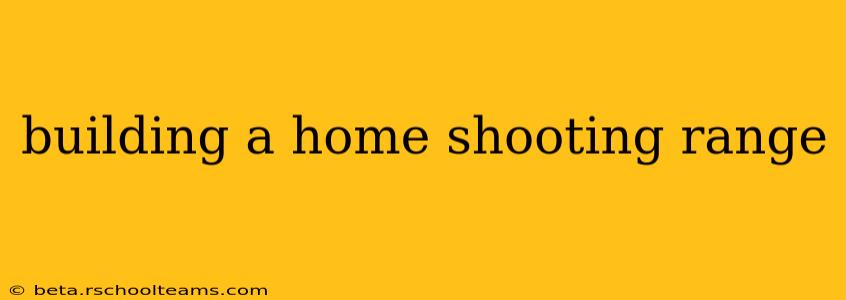Building a home shooting range can be a rewarding project for firearms enthusiasts, offering a safe and controlled environment for practice and training. However, it's crucial to approach this undertaking with meticulous planning and adherence to safety regulations. This comprehensive guide will walk you through the essential steps, from initial design considerations to final safety checks, ensuring you create a responsible and enjoyable shooting space.
Phase 1: Planning and Design
Before breaking ground, thorough planning is paramount. This phase sets the foundation for a safe and effective range.
1.1 Choosing the Right Location:
- Safety First: Select a location far from occupied structures, water sources, and power lines. Consider the potential trajectory of projectiles and ensure a safe backstop is feasible. Local ordinances will dictate minimum distances; consult your local government before proceeding.
- Accessibility and Space: Ensure easy access for equipment and convenient storage for firearms and ammunition. The space needs to accommodate your shooting activities comfortably, allowing for safe movement and target manipulation. Consider the length needed for your longest barrel and add extra distance for safety.
- Environmental Impact: Minimize the environmental footprint. Consider noise pollution and its impact on neighbors. Soundproofing is a key component, discussed in detail later.
1.2 Designing the Range Layout:
- Shooting Stance: Designate clear shooting positions with stable surfaces. Consider adding benches or stands for comfortable shooting.
- Backstop: This is the most critical safety feature. A properly designed backstop must be capable of stopping all projectiles safely, preventing ricochets. Materials like earth berms (highly recommended), steel plates, or purpose-built backstop systems are viable options. Consult with ballistic experts for material specifications based on your caliber.
- Lighting: Adequate lighting is crucial for safety and accuracy. Well-lit areas minimize accidents and improve target visibility.
- Ventilation: Ensure proper ventilation to dissipate gunpowder fumes. This might involve installing exhaust fans or designing the range to maximize natural airflow.
- Target System: Decide on a suitable target system. This could involve hanging targets, stationary targets, or even electronic scoring systems.
Phase 2: Construction and Safety Features
This phase involves the physical construction of your range, prioritizing safety at every stage.
2.1 Backstop Construction:
The backstop is non-negotiable. A poorly designed backstop is the most common cause of range accidents. Consider professional consultation for backstop design, particularly for high-powered rifles. Earth berms offer superior stopping power and are generally the safest option.
2.2 Soundproofing and Noise Reduction:
Noise is a major consideration. Soundproofing materials significantly reduce noise pollution. These may include sound-absorbing panels, specialized insulation, and even strategically placed barriers. Consider the type and thickness of materials based on the expected noise levels.
2.3 Lighting and Electrical:
Install appropriate lighting, ensuring sufficient illumination without glare. Use properly grounded electrical wiring and fixtures, complying with all electrical codes. Avoid running electrical wires where they could be damaged by projectiles.
2.4 Ventilation System:
Install an exhaust system to remove gunpowder residue and fumes. This should be powerful enough to handle the volume of shooting and be properly vented to the outside.
Phase 3: Legal and Regulatory Compliance
Before operating your home shooting range, ensure full compliance with all local, state, and federal regulations.
3.1 Local Ordinances:
Research and understand any local ordinances or zoning regulations concerning firearm ranges. These regulations may dictate minimum distances from property lines, noise limits, and other restrictions.
3.2 Firearm Laws:
Ensure your activities comply with all applicable state and federal firearm laws. This includes proper storage, licensing, and safe handling practices.
3.3 Liability Insurance:
Consider obtaining liability insurance to protect yourself from potential accidents or injuries.
Phase 4: Ongoing Maintenance and Safety
Regular maintenance and safety checks are crucial for responsible range operation.
4.1 Backstop Inspection:
Regularly inspect the backstop for any damage or deterioration. Replace or repair any damaged sections promptly.
4.2 Ventilation System Check:
Ensure the ventilation system operates efficiently, removing fumes effectively.
4.3 Ammunition Storage:
Store ammunition securely and safely, following all recommended guidelines.
Building a home shooting range is a significant undertaking. Prioritizing safety throughout the planning, construction, and operation phases is crucial. Remember that this guide provides a framework; consult with professionals, particularly for aspects such as backstop design and legal compliance, to ensure the safety and legality of your project. Always practice responsible gun ownership and safe shooting habits.
